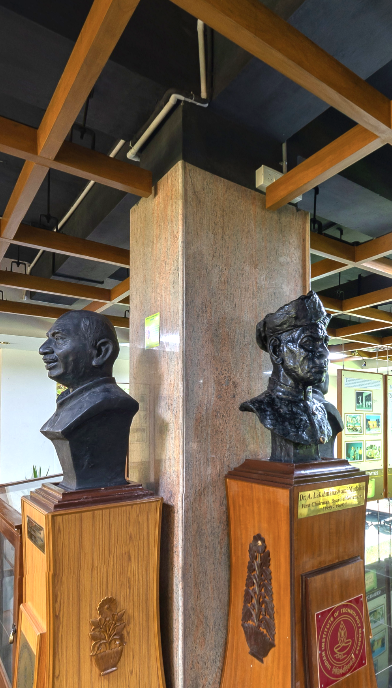
Graduation photograph of Mrs. Shanti Sengupto and her sister Mrs. Maya and friends in 1932
Collection:
Stray Feathers
Album Name:
Photograph ID:
001/0443/0020
Album ID:
Photos contributed by:
Dr. Devaki Bhaya
Description by Mr. J. K. Niyogi:
Prof Bibhuti Bhushan Sengupto, was born in September 1905, in East Bengal.
After his early education in East Bengal and Calcutta, he studied at the Benaras Hindu University, one of the foremost universities of the day and known for its engineering studies. Thereafter he went to England and did further studies at Manchester.
Upon returning from the UK, he joined the Victoris Jubilee Technical Institute - VJTI (now renamed as the Veermata Jijabai Technical Institute) in Bombay before W.War II, then a diploma granting engineering school.
Prof Sengupto rose to become the first Principal and oversaw the conversion of VJTI into a degree giving engineering college of high repute in the 1940s, becoming only the second such college after School of Engineering at Pune in Western India.
Prof Sengupto also served as a Secretary to a high level committee for the upgradation and spread of higher technical education in India.
Following the founding of India's first IIT at Kharagpur in 1950, following the recommendations of the NR Sarkar Commitee, 4 more IITs, including IIT Madras in 1959, were set up and were soon declared as institutes of national importance. IIT Madras was set up with technical, financial and academic assistance by the Govt of West Germany.
Prof B.B.Sengupto was selected as the founder Director of IIT Madras in 1958 and joined IIT Madras in 1959. In the initial years, IIT Madras operated out of makeshift class rooms at AC College and it took 3 years for the first class rooms at the 617 acre campus, which included a part of the Guindy National Park, granted by the Governor of Madras. Prof Radhakrishnan delivered the first convocation address in 1964.
Prof Sengupto set up several teams and worked at break neck speed and in just 5 years from 1959 to 1964, the institute was set up, with separate buildings for the various faculties, several large workshops and laboratories, libraray, hostels for students, living quarters for the teaching and many non teaching staff, roads, an open air theatre, and also a school for the children of the staff. Students from that period recall how the campus was a beehive of construction activity. He used to go round the campus and with an eye for detail would strive for the targeted completion with the best quality. One important principle that he laid down, was that there should be practically no cuting down of major trees. The result is that IIT Madras retained the verdant greenery it was originally bestowed with.
IIT Madras soon achieved reknown. Its outgoing students were considered among the best by employers and other institutes of higher learning where some of the students went for higher studies. Among the many distinguished persons who were present at the convocations were the Nobel Laureate C V Raman. The German Chancellor also visited the institute.
Prof Sengupto was also a member of the University Grants Commission of the Govt of India. He was associated with the West Bengal Govt for a few years in its technical education programme.
Prof Sengupto retired from IIT Madras in 1967. Upon retirement, he went to stay at the bungalow he built by the Ganges at Bandel, where he stayed with his wife Mrs Shanti Sengupto.
Prof Sengupto passed away in 1983 in Calcutta.
- Contribute
to the Centre -
Monetary
Support - Digital
Material











